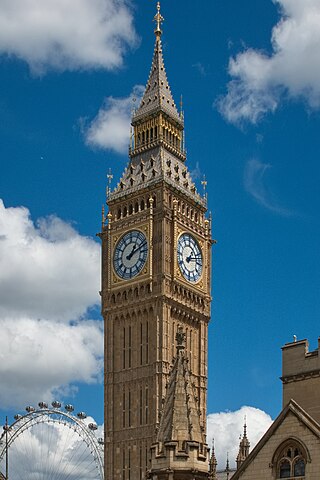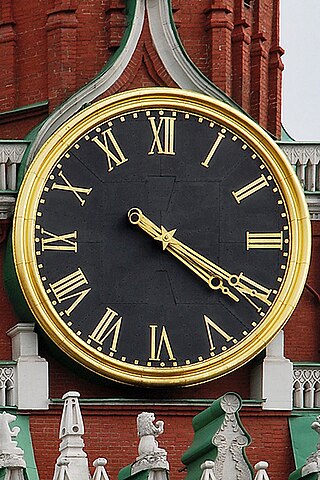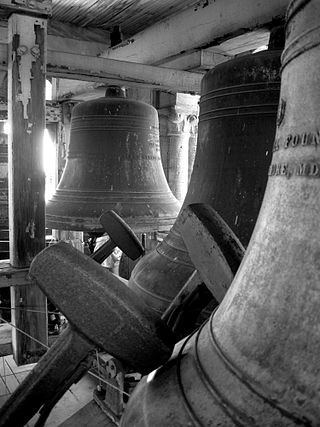
Clock towers are a specific type of structure that house a turret clock and have one or more clock faces on the upper exterior walls. Many clock towers are freestanding structures but they can also adjoin or be located on top of another building. Some other buildings also have clock faces on their exterior but these structures serve other main functions.

St Mary the Great is a Church of England parish and university church at the north end of King's Parade in central Cambridge, England. It is known locally as Great St Mary's or simply GSM to distinguish it from "Little St Mary's". It is one of the Greater Churches. It is designated by Historic England as a Grade I listed building.

A bell is a directly struck idiophone percussion instrument. Most bells have the shape of a hollow cup that when struck vibrates in a single strong strike tone, with its sides forming an efficient resonator. The strike may be made by an internal "clapper" or "uvula", an external hammer, or—in small bells—by a small loose sphere enclosed within the body of the bell.
A grandfather clock is a tall, freestanding, weight-driven pendulum clock, with the pendulum held inside the tower or waist of the case. Clocks of this style are commonly 1.8–2.4 metres (6–8 feet) tall with an enclosed pendulum and weights, suspended by either cables or chains, which have to be occasionally calibrated to keep the proper time. The case often features elaborately carved ornamentation on the hood, which surrounds and frames the dial, or clock face.
A repeater is a complication in a mechanical watch or clock that chimes the hours and often minutes at the press of a button. There are many types of repeater, from the simple repeater which merely strikes the number of hours, to the minute repeater which chimes the time down to the minute, using separate tones for hours, quarter hours, and minutes. They originated before widespread artificial illumination, to allow the time to be determined in the dark, and were also used by the visually impaired. Now they are mostly valued as expensive novelties by watch and clock enthusiasts. Repeaters should not be confused with striking clocks or watches, which do not strike on demand, but merely at regular intervals.

A striking clock is a clock that sounds the hours audibly on a bell, gong, or other audible device. In 12-hour striking, used most commonly in striking clocks today, the clock strikes once at 1:00 am, twice at 2:00 am, continuing in this way up to twelve times at 12:00 mid-day, then starts again, striking once at 1:00 pm, twice at 2:00 pm, up to twelve times at 12:00 midnight.
Whittington chimes, also called St. Mary's, are a family of clock chime melodies associated with St Mary-le-Bow church in London, which is related to the historical figure of Whittington by legend. Whittington is usually the secondary chime selection for most chiming clocks, the first being the Westminster. It is also one of two clock chime melodies with multiple variations, the other being the Ave Maria chimes.

A chime or set of chimes is a carillon-like instrument, i.e. a pitched percussion instrument consisting of 22 or fewer bells. Chimes are primarily played with a keyboard, but can also be played with an Ellacombe apparatus. Chimes are often automated, in the past with mechanical drums connected to clocks and in the present with electronic action. Bellfounders often did not attempt to tune chime bells to the same precision as carillon bells. Chimes are defined as specifically having fewer than 23 bells to distinguish them from the carillon. American chimes usually have one to one and a half diatonic octaves. According to a recent count, there are over 1,300 existing chimes throughout the world. Almost all are in the Netherlands and the United States, with most of the remainder in Western European countries.

Portsmouth Guildhall is a multi-use building in the centre of Portsmouth, Hampshire, England. It is located in a pedestrian square close to Portsmouth and Southsea railway station. Constructed in 1890, the building was known as Portsmouth Town Hall until 1926. It was heavily damaged by bombing during the Second World War and largely rebuilt during the 1950s by the English architect Ernest Berry Webber. It now operates as a concert, wedding and conference venue. It is a Grade II listed building.

The Elizabeth Tower is the clock tower of the Palace of Westminster in London, England. It contains the Great Clock of Westminster, a striking clock with five bells. The tower is nicknamed "Big Ben", which was originally a nickname for the largest bell. The tower was officially called the Clock Tower until 2012, when it was renamed to mark the Diamond Jubilee of Elizabeth II.
Electronic carillon is a blanket term used to refer to an automated system which imitates the sound of a carillon. These systems simulate and amplify bell sounds which are then played from loudspeakers housed in a bell tower.

Carillon de Westminster, Opus 54, No. 6, is a piece written for organ by Louis Vierne. It constitutes the sixth piece in the third suite of Vierne's four-suite set 24 pieces de fantaisie, first published in 1927. Carillon de Westminster is in the key of D major, and is in compound triple time.

Trinity Episcopal Church is an historic church located in north-central Pennsylvania, at 844 West Fourth Street, Williamsport, Pennsylvania. Built in 1875 and consecrated in February 1876, it is the largest of the Episcopal churches in the city. Preservation Williamsport includes the church on its first trolley tour stop.

The Kremlin Clock or Kremlin Chimes, also known colloquially in the West as Moscow Clock Tower, is a historic clock on the Spasskaya Tower of Moscow Kremlin. The clock dial is above the main gates to Red Square. For decades, the chimes have rung on the quarter-hour, with bells tolling for each full hour.
John Warner and Sons was a metalworks and bellfoundry based in various locations in the UK, established in 1739 and dissolved in 1949.

The Waag building is a National monument (Rijksmonument) listed building on the Waagplein in Alkmaar in the Netherlands. On this square Waagplein every Friday from April till the second week of September, the famous cheese market is held. The Dutch Cheese Museum and the tourist information Office (VVV) are also in the building. In the tower is a famous carillon weekly played by a carillonneur and also automatically by a drum chiming the quarters of the hour. There is also the famous automatic horse with knights play in the tower with an automatic trumpetplayer.
A clock chime is a melody or a set of melodies played at intervals upon a set of bells to mark the passage of time. It is also the name of the installed set of bells, when they are not part of a larger bell instrument such as a carillon. Bells that play clock chimes are commonly placed in bell towers and elaborate floor clocks, but may be found any place where a large clock is installed.

The Senior Memorial Chime, known more commonly as the Altgeld Chimes, is a 15-bell chime in Altgeld Hall Tower on the central campus of the University of Illinois Urbana-Champaign, in Urbana, Illinois, United States.
Campanology is the scientific and musical study of bells. It encompasses the technology of bells – how they are cast, tuned, and rung – as well as the history, methods, and traditions of bellringing as an art. Articles related to campanology include:



















